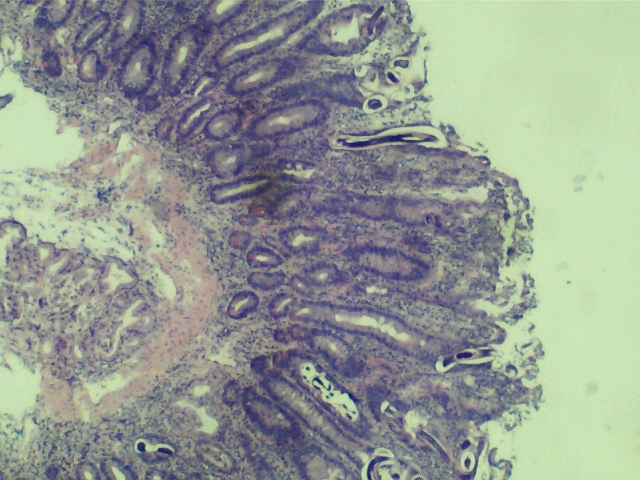Monday Poster Session
Category: Infections and Microbiome
P3469 - Chronic Strongyloidiasis Presenting With Severe Sepsis and Hemorrhagic Enteritis: A Case Report
Monday, October 27, 2025
10:30 AM - 4:00 PM PDT
Location: Exhibit Hall

Jill Bhavsar, MD (she/her/hers)
Wellstar Health System - Cobb Medical Center
Austell, GA
Presenting Author(s)
Jill Bhavsar, MD, Manjusha Das, MD
Wellstar Health System - Cobb Medical Center, Austell, GA
Introduction: Strongyloidiasis caused by Strongyloides stercoralis is estimated to be responsible for around 30-100 million infections annually. Unique presentations of this infection pose a diagnostic challenge and delayed treatments. This case highlights that chronic untreated Strongyloides infection can result in disseminated fatal presentations through the auto-infectious nature of the parasite.
Case Description/
Methods: A 64 year old Haitian male presented with decreased appetite, abdominal bloating, weight loss and bilateral hip pain. He had moved to the United States 4 months ago. On initial presentation, he was in severe sepsis with hypotension and lactic acidosis suspected secondary to enteritis and pneumonia. Severe anemia and peripheral eosinophilia was noted on initial blood work prompting gastrointestinal evaluation. Esophagogastroduodenoscopy was done which showed acute duodenitis with hemorrhage, characterized by erythema, friability and congestion and findings suggestive of infectious enteritis. Stool ova and parasites (O&P) came back positive for Strongyloides stercoralis rhabditiform larvae. Echocardiography showed severe pulmonary hypertension- pulmonary artery systolic pressure of 71 mmHg with mean pressure of 45 mmHg. Treatment with ivermectin was started for 1 month and albendazole for 7 days for severe disease. Repeat stool O&P was negative and albendazole was discontinued. The patient was asked to follow up with an infectious disease specialist in 2 weeks.
Discussion: Strongyloides infection is commonly transmitted by barefoot walking in endemic areas of Southeast Asia, Africa and Western Pacific regions. It can have a broad spectrum of disease presentations depending upon the host’s immune status and parasite load. Hyperinfection syndrome occurs due to repeated auto-infection and extremely high parasitic load in skin, lungs and gastrointestinal tract. Disseminated infections occur when Strongyloides migrates out of his normal pathway. Individuals with weak immune systems and chronic medical problems like malnutrition, diabetes, chronic kidney disease and alcoholism are at a greater risk of complications. Notably, chronic strongyloidiasis also puts individuals at a higher risk for hyperinfection and disseminated infections. They are asymptomatic or with mild symptoms on presentation but can have mortality rates as high as 87.1 - 100% without treatment. Thus a high level of clinical suspicion is necessary for prompt diagnosis and treatment of these cases to reduce mortality rates.

Figure: Low power gastric mucosa with parasites.

Figure: Duodenal image of duodenitis.
Disclosures:
Jill Bhavsar indicated no relevant financial relationships.
Manjusha Das indicated no relevant financial relationships.
Jill Bhavsar, MD, Manjusha Das, MD. P3469 - Chronic Strongyloidiasis Presenting With Severe Sepsis and Hemorrhagic Enteritis: A Case Report, ACG 2025 Annual Scientific Meeting Abstracts. Phoenix, AZ: American College of Gastroenterology.
Wellstar Health System - Cobb Medical Center, Austell, GA
Introduction: Strongyloidiasis caused by Strongyloides stercoralis is estimated to be responsible for around 30-100 million infections annually. Unique presentations of this infection pose a diagnostic challenge and delayed treatments. This case highlights that chronic untreated Strongyloides infection can result in disseminated fatal presentations through the auto-infectious nature of the parasite.
Case Description/
Methods: A 64 year old Haitian male presented with decreased appetite, abdominal bloating, weight loss and bilateral hip pain. He had moved to the United States 4 months ago. On initial presentation, he was in severe sepsis with hypotension and lactic acidosis suspected secondary to enteritis and pneumonia. Severe anemia and peripheral eosinophilia was noted on initial blood work prompting gastrointestinal evaluation. Esophagogastroduodenoscopy was done which showed acute duodenitis with hemorrhage, characterized by erythema, friability and congestion and findings suggestive of infectious enteritis. Stool ova and parasites (O&P) came back positive for Strongyloides stercoralis rhabditiform larvae. Echocardiography showed severe pulmonary hypertension- pulmonary artery systolic pressure of 71 mmHg with mean pressure of 45 mmHg. Treatment with ivermectin was started for 1 month and albendazole for 7 days for severe disease. Repeat stool O&P was negative and albendazole was discontinued. The patient was asked to follow up with an infectious disease specialist in 2 weeks.
Discussion: Strongyloides infection is commonly transmitted by barefoot walking in endemic areas of Southeast Asia, Africa and Western Pacific regions. It can have a broad spectrum of disease presentations depending upon the host’s immune status and parasite load. Hyperinfection syndrome occurs due to repeated auto-infection and extremely high parasitic load in skin, lungs and gastrointestinal tract. Disseminated infections occur when Strongyloides migrates out of his normal pathway. Individuals with weak immune systems and chronic medical problems like malnutrition, diabetes, chronic kidney disease and alcoholism are at a greater risk of complications. Notably, chronic strongyloidiasis also puts individuals at a higher risk for hyperinfection and disseminated infections. They are asymptomatic or with mild symptoms on presentation but can have mortality rates as high as 87.1 - 100% without treatment. Thus a high level of clinical suspicion is necessary for prompt diagnosis and treatment of these cases to reduce mortality rates.

Figure: Low power gastric mucosa with parasites.

Figure: Duodenal image of duodenitis.
Disclosures:
Jill Bhavsar indicated no relevant financial relationships.
Manjusha Das indicated no relevant financial relationships.
Jill Bhavsar, MD, Manjusha Das, MD. P3469 - Chronic Strongyloidiasis Presenting With Severe Sepsis and Hemorrhagic Enteritis: A Case Report, ACG 2025 Annual Scientific Meeting Abstracts. Phoenix, AZ: American College of Gastroenterology.
